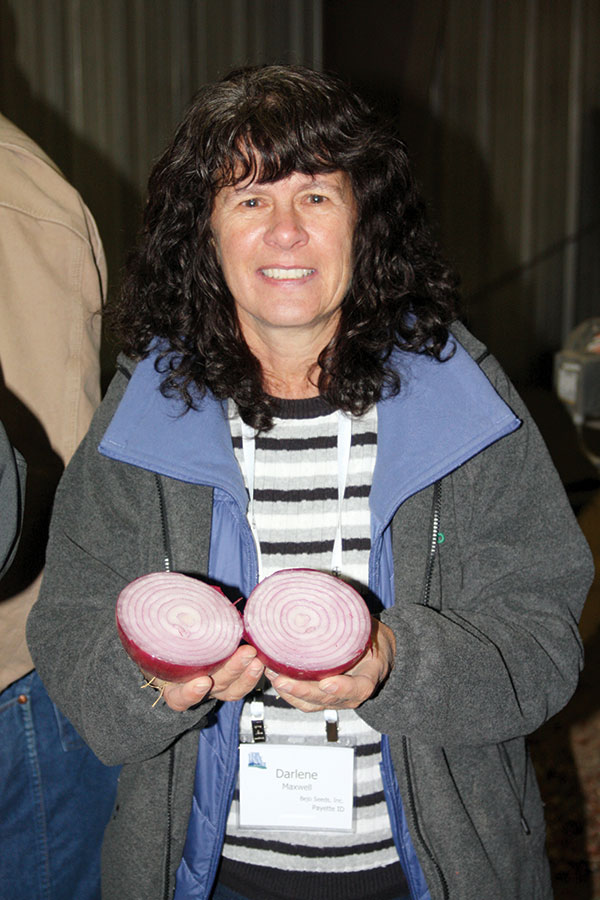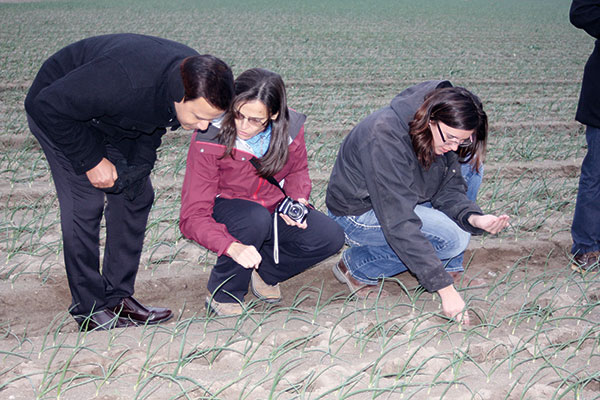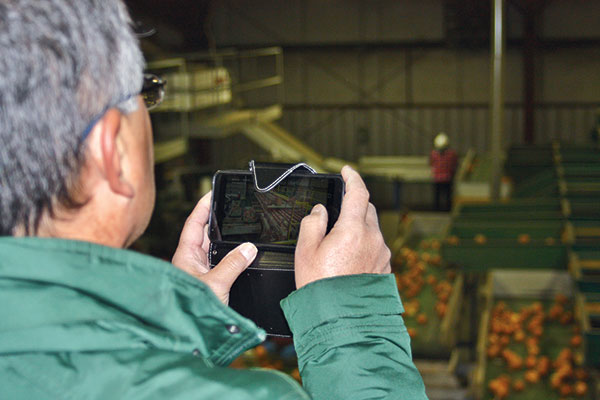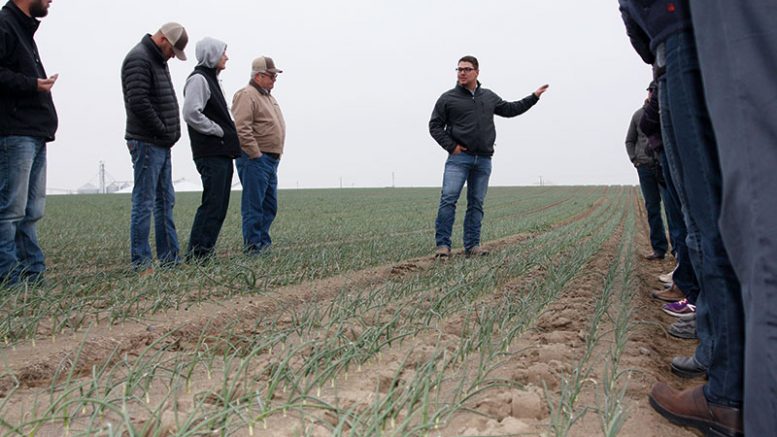A field trip to an onion farm and packing shed, along with research updates on some of the onion industry’s greatest challenges were among the items on the agenda for the annual meeting of the SAES-422 Multistate Research Project W-3008: Integrated Onion Pest and Disease Management. Over 40 onion specialists, producers, breeders, consultants, agronomists, packers and others gathered in Kennewick, Washington, to attend the Nov. 13 meeting.

Research Reports
In addition to state-by-state reports on onion production acreage, growing conditions and issues encountered in 2018, the group also heard brief research reports on half a dozen topics.
Rob Wilson with the University of California presented an update on onion white rot and maggot pesticide efficacy trials. He noted that seedcorn and onion maggot have become an increasing pest of concern to onion growers in California, who can no longer use Lorsban in-furrow. They observed some control of maggot with seed treatments (Sepresto 75WS, Farmore 500 and Regard).
James Woodhall with the University of Idaho delivered an overview of some of the main onion issues he has been working on in the Treasure Valley, particularly characterizing soil-borne diseases and field trials on disease management. He has been evaluating predictive soil testing for the pink root, Fusarium basal rot and Pythium root rot pathogens. He noted that rotation of onion with corn may be increasing disease pressure for Fusarium proliferatum colonizing onion necks/bulbs late in the season.
Chris Cramer from New Mexico State University gave an update on his short-day onion breeding program to develop cultivars with resistance to Fusarium basal rot.

Christy Hoepting from Cornell University shared results of research she conducted with colleagues Sarah Pethybridge and Frank Hays. The work looked at insensitivity of isolates of the Stemphylium leaf blight pathogen to fungicides in the FRAC (Fungicide Resistance Action Committee) Group 11, the strobilurins such as azoxystrobin and pyraclostrobin, and FRAC Group 7, such as boscalid (e.g., the active ingredient in Endura). The researchers are also seeing evidence of resistance developing to the fungicide iprodione (Rovral). Also at Cornell, Steve Beer’s phytobacteriology program has identified a gene cluster in the center rot pathogen, Pantoea ananatis, that is critical for the ability to cause disease on onion.
Hanu Pappu with Washington State University updated the group on his continued work looking at the genetic diversity of strains of Iris yellow spot virus.
Beth Gugino with Pennsylvania State University spoke about the Allium leafminer situation in the northeastern U.S. led by entomologist Shelby Fleischer. Foliar applications of the insecticides Scorpion and Exirel reduced populations of the Allium leafminer significantly. The researchers are also looking into a parasitoid wasp found in Allium leafminer pupae to see if it can be identified and reared for potential biocontrol of this new pest to the U.S.

Additional Discussion
The group also discussed federal grant proposals to support onion research. Pappu commented on the thrips and white rot USDA NIFA SCRI proposal that was funded in 2018 and led by Washington State University (WSU) with Cornell University, New Mexico State University, Oregon State University and the University of Idaho. Another SCRI proposal on onion bacterial diseases led by WSU’s Lindsey du Toit and submitted in March 2018 was ranked highly by reviewers but was not funded. The proposal will be re-submitted this winter.
Attendees brainstormed and discussed onion research and extension needs across the country. A common theme that emerged is the interest in soil health in onion production, particularly in relation to soil-borne diseases like pink root that are almost ubiquitous across the country.
Bhabesh Dutta from the University of Georgia gave an overview on the Alliumnet website www.alliumnet.com and encouraged members of the W-3008 to submit articles, information, publications and posters to be shared on the website. Alliumnet currently has 667 subscribers with 70 percent of the users located in the U.S. The minutes of the W-3008 annual meeting will be posted on that website.

Plans for 2019
The W-3008 multi-state project builds on the five-year W-1008 project initiated by Howard Schwartz at Colorado State University, which was followed by the five-year W-2008 project led by Brian Nault at Cornell University. The five-year W-3008 project began in 2018.
For 2019, Gugino will step up as chair of the W-3008, with Dutta serving as vice-chair, Peter Rogers from Nunhems/BASF as secretary and Hoepting as immediate past-chair.
The next W-3008 annual meeting will be combined with the meeting of the National Onion Association, National Allium Research Conference and International Allium Research Symposium on July 24-27, 2019, in Madison, Wisconsin. For details, visit www.onions-usa.org/narc-iars-conference.


